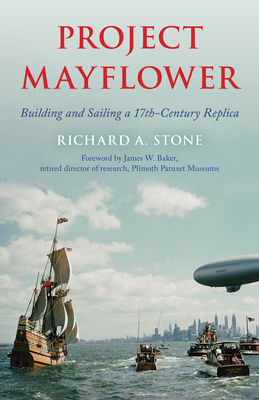Project Mayflower: Building and Sailing a Seventeenth-Century Replica

Project Mayflower: Building and Sailing a Seventeenth-Century Replica
The Mayflower II--the replica of the 1620 ship that brought the Pilgrims to America and launched a nation--is seen by some 2.6 million visitors to Plymouth annually and listed on the National Register of Historic Places. But there is much more to the replica's story than meets the eye. In fact, the origins of Project Mayflower began in the 1950s not with an American, but with a British World War II veteran named Warwick Charlton who had what seemed an impossible dream: to build a historically accurate replica, sail her across the Atlantic, and present the finished product as a thank-you to his country's wartime ally.
What Charlton didn't know was that the son of a powerful New England financier had the same idea. Henry "Harry" Hornblower II wanted a replica just as badly, though for a different reason: as the star attraction for a new museum he was building in Massachusetts, soon to be known as Plimoth Plantation, where the original Mayflower had landed centuries before. Despite clearly different personal motives, Charlton and Hornblower agreed to join forces when they met by chance in 1955. Charlton would be responsible for financing, construction, and the vessel's safe passage across the Atlantic, while Hornblower promised mooring, maintenance, and exhibition. Neither man could imagine what would happen next.
Project Mayflower recounts the never-before-told story of a grand adventure, from the origins of the idea, through the financial and political influences that nearly scuttled the ship, and the challenges of building an accurate replica based on a single known mention: William Bradford's reference in Of Plimoth Plantation describing his craft simply as "180 tons of burden." From there, Stone traces the Mayflower II's dramatic seven-week ocean voyage from Plymouth, England, to Plymouth, Massachusetts, in the skilled hands of Alan Villiers and a crew of thirty-three bold men, and finishes by exploring the legacy of praise for the achievement, the skulduggery to tarnish the reputation of the project's creator, and finally the Mayflower II's lasting--and ongoing--impact on the United States of America.
PRP: 234.00 Lei
Acesta este Prețul Recomandat de Producător. Prețul de vânzare al produsului este afișat mai jos.
210.60Lei
210.60Lei
234.00 LeiLivrare in 2-4 saptamani
Descrierea produsului
The Mayflower II--the replica of the 1620 ship that brought the Pilgrims to America and launched a nation--is seen by some 2.6 million visitors to Plymouth annually and listed on the National Register of Historic Places. But there is much more to the replica's story than meets the eye. In fact, the origins of Project Mayflower began in the 1950s not with an American, but with a British World War II veteran named Warwick Charlton who had what seemed an impossible dream: to build a historically accurate replica, sail her across the Atlantic, and present the finished product as a thank-you to his country's wartime ally.
What Charlton didn't know was that the son of a powerful New England financier had the same idea. Henry "Harry" Hornblower II wanted a replica just as badly, though for a different reason: as the star attraction for a new museum he was building in Massachusetts, soon to be known as Plimoth Plantation, where the original Mayflower had landed centuries before. Despite clearly different personal motives, Charlton and Hornblower agreed to join forces when they met by chance in 1955. Charlton would be responsible for financing, construction, and the vessel's safe passage across the Atlantic, while Hornblower promised mooring, maintenance, and exhibition. Neither man could imagine what would happen next.
Project Mayflower recounts the never-before-told story of a grand adventure, from the origins of the idea, through the financial and political influences that nearly scuttled the ship, and the challenges of building an accurate replica based on a single known mention: William Bradford's reference in Of Plimoth Plantation describing his craft simply as "180 tons of burden." From there, Stone traces the Mayflower II's dramatic seven-week ocean voyage from Plymouth, England, to Plymouth, Massachusetts, in the skilled hands of Alan Villiers and a crew of thirty-three bold men, and finishes by exploring the legacy of praise for the achievement, the skulduggery to tarnish the reputation of the project's creator, and finally the Mayflower II's lasting--and ongoing--impact on the United States of America.
Detaliile produsului










